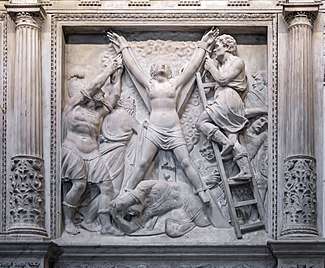Eulalia of Barcelona
Saint Eulalia (Aulaire, Aulazia, Olalla, Eulària) (c. 290–February 12, 303), co-patron saint of Barcelona, was a 13-year-old Roman Christian virgin who suffered martyrdom in Barcelona during the persecution of Christians in the reign of emperor Diocletian (although the Sequence of Saint Eulalia mentions the "pagan king" Maximian), towards the end of the ban on Christianity. There is some dispute as to whether she is the same person as Saint Eulalia of Mérida, whose story is similar.[1]
Saint Eulalia of Barcelona | |
|---|---|
 Tomb of Saint Eulalia in the crypt of Barcelona Cathedral | |
| Born | c. 290 Barcelona, Hispania (Spain) |
| Died | February 12, 303 (aged 13) Barcelona, Hispania |
| Venerated in | Roman Catholicism and Eastern Orthodoxy |
| Canonized | 633 |
| Major shrine | Cathedral of Santa Eulàlia, Barcelona |
| Feast | February 12 (August 22 in the Orthodox Church) |
| Attributes | X-shaped cross, stake, and dove |
| Patronage | Barcelona, Spain; sailors; against drought |
History


The daughter of a noble family, Eulalia lived near the city of Barcelona. During the persecutions under Diocletian, governor Dacian arrived in the city intent on enforcing the decrees. Eulalia went to the city and confronted the governor, denouncing him for his persecution of Christians. Unable to dismiss her eloquent appeals, Dacian had her stripped and flogged. Afterwards, she was tortured with various implements until she would deny her beliefs or die. Her wounds were burned with torches, but the flames blew back against her tormentors. She prayed that God would take her to Heaven, then died.[2]
A dove is supposed to have flown forth from her mouth following her death, then a sudden snowstorm covered her mostly nude body like a garment.[2]
It is traditionally believed that her tortures culminated in her crucifixion on an X-shaped cross, and she is depicted with this cross as the instrument of her martyrdom. However, it has been posited that she was instead publicly tortured on an X frame and left there after she died, artistic depictions of which leading to the later belief that she was crucified.[3]

Veneration
There are a number of similarities with the description of the martyrdom of Eulalia of Mérida.
Her body was originally interred in the church of Santa Maria de les Arenes (St. Mary of the Sands; now Santa Maria del Mar, St. Mary of the Sea). It was hidden in 713 during the Moorish invasion, and only recovered in 878. In 1339, it was relocated to an alabaster sarcophagus in the crypt of the newly built Cathedral of Santa Eulalia.[4] The festival of Saint Eulalia is held in Barcelona for a week around her feast day on February 12.[5]
Eulalia is commemorated with statues and street names throughout Barcelona.[6] Baixada de Santa Eulàlia "Saint Eulalia's descent") reflects a tradition that Eulalia was placed in a barrel with shards of glass and rolled down a street.[6]
See also
- Sequence of Saint Eulalia – French hagiography from AD 880
- Saint Eulalia of Barcelona, patron saint archive
References
- Haliczer, Stephen (2002). Between exaltation and infamy: Female mystics in the Golden Age of Spain. Oxford: Oxford University Press. p. 236. ISBN 0-19-514863-0.
- "Virginmartyr Eulalia of Barcelona", Orthodox Church in America
- Santa Eulalia de Barcelona (in Spanish)
- Santa Maria del Mar Archived 2006-02-05 at the Wayback Machine from The New York Times travel guide.
- Festes de Santa Eulàlia from Barcelona municipal website (in Catalan)
- Vázquez Montalbán, Manuel (1992). Barcelonas. London: Verso. p. 42. ISBN 0-86091-353-8.
| Wikimedia Commons has media related to Saint Eulalia of Barcelona. |
External links
- St. Eulalia of Barcelona from the Catholic Encyclopedia
- Saint of the Day, February 12: Eulalia of Barcelona at SaintPatrickDC.org
- Eulalia of Barcelona at Find a Grave
- St. Eulalia page at the Christian Iconography web site